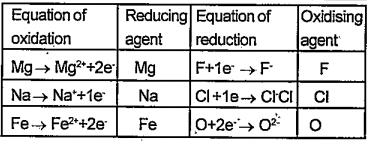Electron tranfer during the formation of sodium chloride can be written in the form of an equation
Na→Na++1e−
Cl+1e−→Cl−.Solution in Malayalam
The correct Answer is:During the formation of sodium chloride sodium atom donates electron and gets converted to sodium ion (Na+) chlorine accepts an electron to form chloride ion (Cl−).
Step by step video, text & image solution for Electron tranfer during the formation of sodium chloride can be written in the form of an equation NararrNa^(+)+1e^(-) Cl+1e^(-)rarrCl^(-). by Chemistry experts to help you in doubts & scoring excellent marks in Class 9 exams.
Topper's Solved these Questions
Similar Questions
Explain the earlier attempt of classification by Lavoiser?
View SolutionWhich of the following combination of axial & equitorial bonds show Cis or Trans orientation in Dimethyl cyclohexane. (i) 1e, 2e (ii) 1e, 3e (iii) 1e, 4e (iv) 1e, 2a (v) 1e, 3a (vi) 1e, 4a (vii) 1a, 3a
02:40View Solutionint_(1-)^1e^([x])dx The value of
01:53View SolutionEvaluate ∫10e2x dx
02:14View SolutionFill in the blanks: ""-1e^0 Is expressed by ______.
03:35View SolutionEvaluate
∫1−1e|x|dx00:57View SolutionI=∫1−1exdx
05:05View SolutionAnalyze the electron transfer in each atom during the formation of sodium chloride.
00:38View SolutionComplete the equation of this process.
Cl+1e−→.............01:28View SolutionCl + 1e^- rarr Cl^(1-) which atom is reduced ?
01:21View SolutionCl+1e−→Cl1−
Which is the oxidising agent in this chemical reaction ?04:55View SolutionAnalyse the following equations and complete the table given below
1. Mg→Mg2++2e− F+1e−→F 2. Na→Na++1e− Cl+1e−→Cl 3. Fe→Fe2++2e− O+2e−→O2−
 04:39View Solution
04:39View SolutionWhich of the following combination of axial & equitorial bonds show Cis or Trans orientation in Dimethyl cyclohexane.
(i) 1e, 2e (ii) 1e, 3e (iii) 1e, 4e (iv) 1e, 2a (v) 1e, 3a (vi) 1e, 4a (vii) 1a, 3a05:04View SolutionEvaluate ∫1−1e|x|dx
02:14View SolutionThe direction of electron flow in certain gal-vanic cells are given below. (Symbols are not real) BrarrA , ErarrC , DrarrE , ArarrD : Choose the reaction taking place at 'C' in cell (ii) ErarrC . Give the reason. C^+(aq)+1e rarrC(s) , C(s)rarrC^+(aq)+1e^- , C(s)rarrC^+(aq)+1e^-
02:50View Solution

